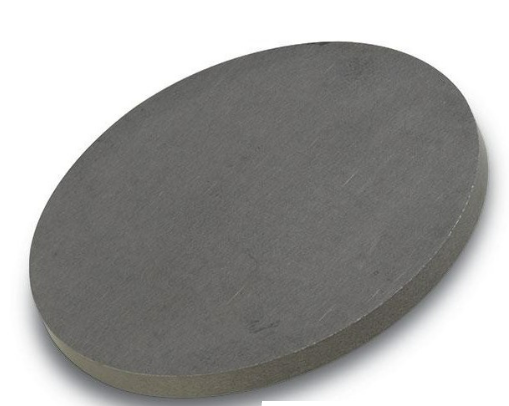Tantalum Nitride Sputtering Target (For tantalum nitride TaN thin films)
Princeton Powder is a leading supplier of high-purity (4N) Tantalum Nitride (TaN) sputtering targets, primarily used in thin-film deposition for the semiconductor and microelectronics industries. These targets are also suitable for applications in semiconductor manufacturing, chemical vapor deposition (CVD), physical vapor deposition (PVD), display technology, and optical and decorative coatings.
TaN targets are optimized for both direct current (DC) and radio frequency (RF) sputtering, depending on specific environmental needs. Impurity levels are tightly controlled. High flatness and an excellent surface finish are achieved. Optional backing materials, such as Copper or Molybdenum, are available. Tantalum Nitride sputtering targets are offered at competitive prices in the United States.
Material | Tantalum Nitride (TaN) sputtering targets |
CAS Number | 12033-62-4 |
Purity | 99.9%, 4N |
Shape | Discs, Plates, Column Targets, Step Targets, Custom-made |
| Density | 14.3 g/cm3 |
Melting Point | 3090 ℃ |
Dimensions | Dia.: 2.0″, 3.0″, 4.0″, 5.0″, 6.0″ Thick: 0.125″, 0.250″ |
Bonding | With Bonding, or customized |
Backing Material | Molybdenum Or Copper |
Description of Tantalum Nitride Sputtering Target
Tantalum Nitride, also known as TaN, is a nitride compound of tantalum. It exhibits excellent properties such as high thermal stability, chemical resistance, and electrical conductivity, making it suitable for use in thin-film deposition, semiconductor processing, and protective coatings. Engineered to deliver uniform films, these targets maintain controlled impurity levels and high flatness for consistent performance in demanding environments.
Dimensions of Tantalum Nitride Sputtering Target
Circular Sputtering Targets | Diameter | 1.0” 2.0” 3.0” 4.0” 5.0” 6.0” Customized |
Rectangular Sputtering Targets | Width x Length | 5” x 12” 5” x 15” 5” x 20” 5” x 22” 6” x 20” Customized |
Thickness can be customized (With/No Bonding) | 0.125”, 0.25” Customized | |
Tantalum Nitride Sputtering Target Application
Semiconductor Manufacturing: TaN serves as an effective diffusion barrier for copper interconnects, preventing copper migration into dielectric materials, which is critical for maintaining device integrity and performance.
Thin-Film Deposition: Used in the deposition of high-quality thin films in microelectronics, TaN contributes to improved performance in integrated circuits and electronic devices.
Chemical Vapor Deposition (CVD): TaN is utilized in CVD processes to create protective and functional coatings on various substrates, enhancing durability and performance.
Physical Vapor Deposition (PVD): In PVD applications, TaN targets are employed to produce hard, wear-resistant coatings, suitable for tools and components subjected to harsh conditions.
Optical Coatings: TaN films are used in optical applications due to their conductive properties, providing essential functionality in filters and mirrors.
Decorative Coatings: The aesthetic appeal and durability of TaN make it suitable for decorative coatings in consumer electronics and automotive applications.
Tantalum Nitride Sputtering Target Scholar Articles
Electrical and mechanical properties of tantalum nitride thin films deposited by reactive sputtering
The electrical resistivity and mechanical hardness of reactively sputtered tantalum nitride (TaN) thin films on ceramic substrates have been investigated. Depending on the nitrogen/argon gas flow rate ratio (defined as R), the resistivity of the tantalum nitride films varied unusually widely (107 orders) from metal to insulator. The big increase in the resistivity of the tantalum nitride films as the R value increased may be due to the theoretically predicted Ta vacancies and anti-site defects (excess N atoms occupying Ta sites) or thermodynamically stable N-rich phase formation under N-rich conditions. N-rich TaN film in this study (R=2) had a dramatically increased resistivity and seems to be a good candidate material as a seed layer and a capping layer of GMR sensor in data storage, while low-resistive stoichiometric TaN (R=0.5) is a good candidate material as a barrier layer in semiconductors with its low contact resistance. The hardnesses of underlayer (10 μm Al2O3), 100 nm Al2O3, and two TaN films (R=1 and 2) were similar and between 600 and 1600 kg/mm2. The hardness of the TaN film did not change much as the N content increased in this study, which seems to indicate that N-rich thermodynamically stable phases such as tetragonal Ta4N5 or orthorhombic Ta3N5 (rather than TaN film with anti-site defects) have been formed as the N content increased.

